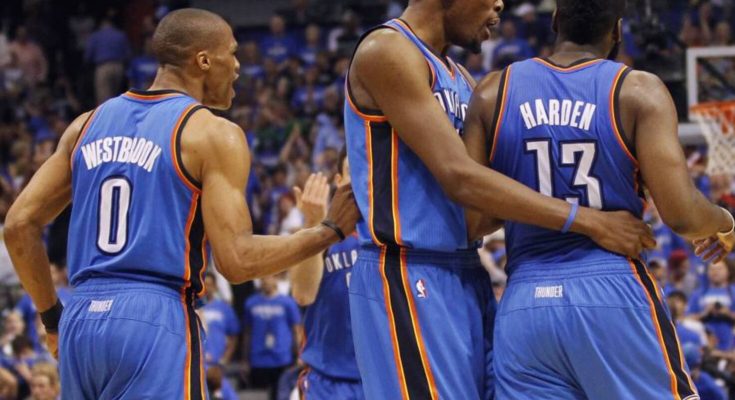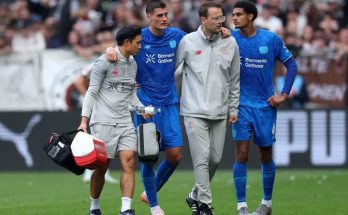BREAKING: The Oklahoma City Thunder currently have a 52% chance to make the Finals again! That simple percentage might seem like a technical detail, but for Thunder fans and NBA analysts alike, it signals something monumental: the Oklahoma City Thunder, a team once regarded as being in a long-term rebuild, are now positioned as legitimate contenders on the cusp of basketball immortality. This percentage, calculated by advanced forecasting models that take into account team efficiency, roster strength, health, depth, and current playoff trajectory, paints a picture of a young, hungry squad that’s no longer knocking on the door of greatness—they’re halfway through it.
The Thunder’s journey to this point hasn’t been easy. Just a few years ago, Oklahoma City was synonymous with youth, draft picks, and patient rebuilding. They had traded away superstars, loaded up on draft capital, and committed to developing homegrown talent. Critics saw them as a team destined to linger in the lottery for years. But Sam Presti, the team’s methodical general manager, had a different vision. Through shrewd drafting, smart trades, and a culture that emphasized development, toughness, and unselfish play, the Thunder’s rebuild accelerated faster than most expected.
At the heart of this transformation is Shai Gilgeous-Alexander, a player who has morphed from promising young guard to full-blown superstar. His offensive efficiency, creative playmaking, and defensive tenacity have turned him into one of the NBA’s elite two-way players. His leadership on and off the court is a major reason why Oklahoma City has not only climbed the Western Conference standings but has looked dominant doing so. Every playoff run needs a player who can carry a team through adversity, and SGA has proven time and time again that he can be that player.
But the Thunder’s 52% chance to make the Finals isn’t just about one star. It’s about a collective effort, built on a team-oriented philosophy that emphasizes ball movement, spacing, and unrelenting defense. Chet Holmgren, finally healthy and producing at a high level, has transformed the Thunder’s interior presence. His shot-blocking, rim protection, and ability to stretch the floor have made him a perfect modern big man for today’s NBA. Then there’s Jalen Williams, whose versatility allows him to defend multiple positions and contribute offensively with slashing drives, perimeter shooting, and high basketball IQ. Josh Giddey’s evolution as a secondary playmaker and rebounder also adds to the depth and unpredictability of the Thunder’s offensive schemes.
Role players like Isaiah Joe, Lu Dort, and Aaron Wiggins have embraced their jobs with energy and precision. Dort, in particular, has been crucial in guarding opposing stars, while Joe’s three-point shooting has added a layer of danger to OKC’s perimeter attack. The bench unit, often the difference-maker in playoff series, has consistently outperformed expectations, bringing energy and scoring in critical moments.
Head coach Mark Daigneault deserves credit as well. His calm demeanor, ability to connect with players, and tactical awareness have turned the Thunder into one of the best-coached teams in the league. His rotations are smart, his adjustments timely, and his trust in his young core unwavering. Daigneault’s system allows for creativity within structure—a key reason why the Thunder consistently outperform more veteran-laden teams.
Statistically, the Thunder’s defensive and offensive ratings are both top-tier. Their net rating puts them among the NBA’s elite, and their clutch-time performances have been among the best in the league. Whether in fast-break situations, half-court sets, or late-game execution, the Thunder display a maturity and poise that belies their youth. Their ability to close games has become a hallmark of their rise, and this is especially crucial in the playoffs, where tight contests and momentum swings define series outcomes.
Of course, a 52% chance isn’t a guarantee. The Western Conference remains a battlefield. Teams like the Denver Nuggets, Minnesota Timberwolves, Dallas Mavericks, and even the defending champion Golden State Warriors present real threats. Each has experience, star power, and their own aspirations of lifting the Larry O’Brien Trophy. But what sets the Thunder apart is their balance—there are no glaring weaknesses, no major injury issues, and no reliance on a single player to carry the load.
Their versatility allows them to match up with a variety of playing styles. Against teams like the Warriors or the Mavericks, OKC can go small and push the pace. Against bigger, more physical teams like the Nuggets or the Timberwolves, Holmgren’s mobility and length provide enough interior coverage to keep things competitive. Their transition defense is among the best in the league, and their ability to generate points off turnovers makes them especially dangerous.
Momentum also plays a role here. The Thunder didn’t just sneak into the playoff picture—they stormed into it, playing some of their best basketball late in the regular season and carrying that energy into the postseason. Analysts and fans have started to shift their perspective from viewing OKC as a “fun young team” to seeing them as a “serious Finals threat.” That mental shift is as significant as any stat or model projection. Confidence begets performance, and the Thunder are overflowing with both.
In addition, the Thunder’s youth might actually be their secret weapon. While most playoff teams rely on seasoned veterans, OKC thrives on energy, legs, and relentless hustle. There’s a fearlessness in this team—a belief that they belong on the biggest stage. They’re not weighed down by past failures or playoff baggage. Instead, they’re propelled by hunger and belief.
Another overlooked aspect is how well this Thunder team fits together. Chemistry matters in high-stakes basketball. The core of this team has grown up together. They’ve learned each other’s tendencies, strengths, and weaknesses. There’s no ego battle, no jostling for attention. It’s a group of players who enjoy playing for one another, who celebrate the success of their teammates as much as their own. That kind of unity is rare, and it’s a major reason why they’ve overachieved according to some and are now on the cusp of something historic.
There’s also a level of tactical flexibility that most contenders can’t replicate. The Thunder can win in a shootout, or they can grind it out defensively. They can run with fast-paced teams or slow the tempo when needed. This adaptability makes them especially dangerous in a seven-game series, where adjustments determine outcomes.
A 52% chance to make the Finals means more than just a coin flip—it means the Thunder are now expected to make it further than nearly every team in the NBA. It’s a recognition of their consistency, their growth, and their ability to deliver under pressure. The models and algorithms are simply catching up to what Thunder fans have felt brewing all season long.
The road ahead won’t be easy. The NBA Playoffs are unforgiving, and a single injury or cold shooting night can shift momentum. But if the numbers are any indication, the Oklahoma City Thunder are more than just a feel-good story. They are poised for greatness. And if the odds hold, they could very well be representing the Western Conference in the NBA Finals—a place they haven’t been since 2012, when a much younger core led by Kevin Durant, Russell Westbrook, and James Harden took the league by storm.
This current iteration of the Thunder, built differently but driven by the same desire to win, is ready to write its own chapter in franchise history. A 52% chance means they’re not chasing history—they’re creating it. And the rest of the NBA better take notice.



